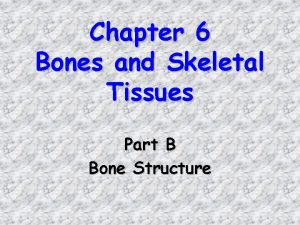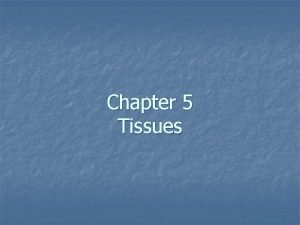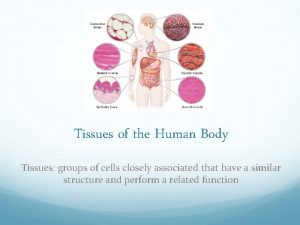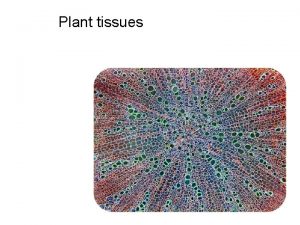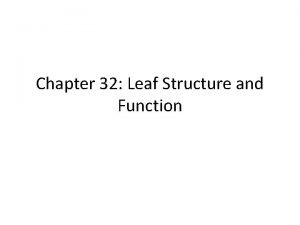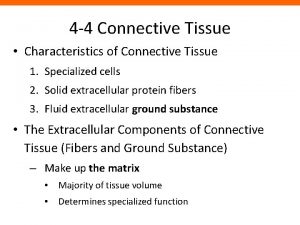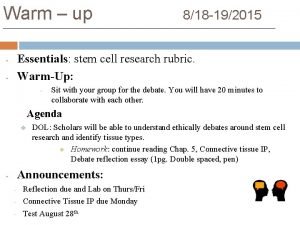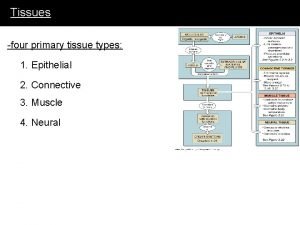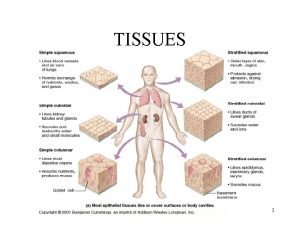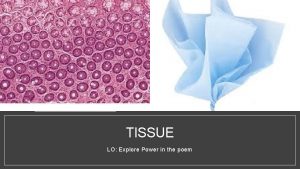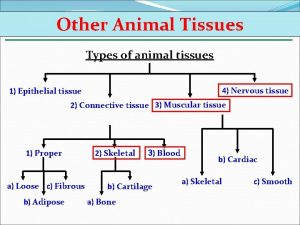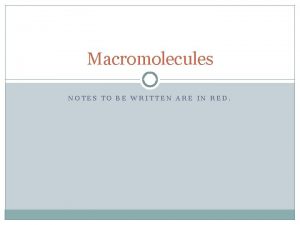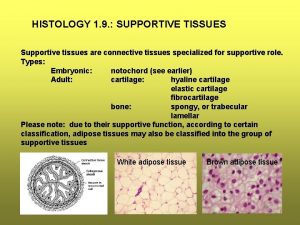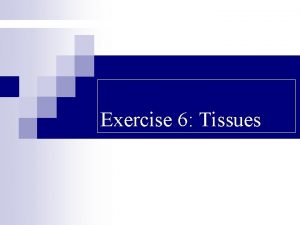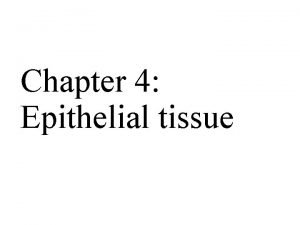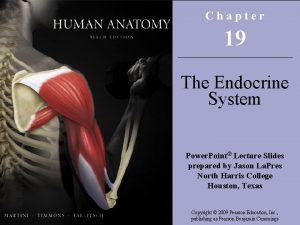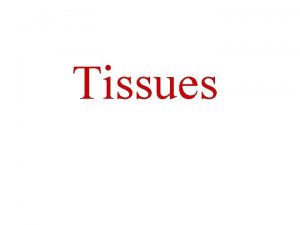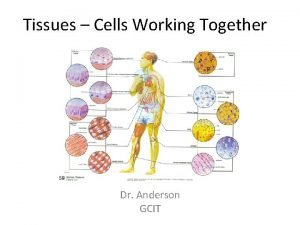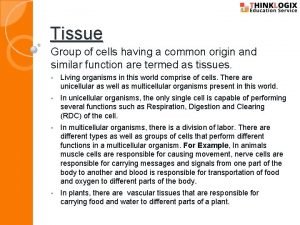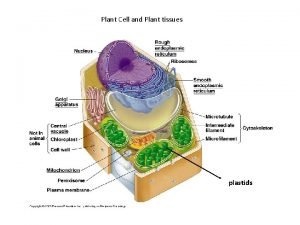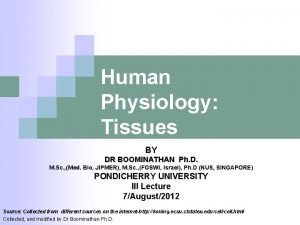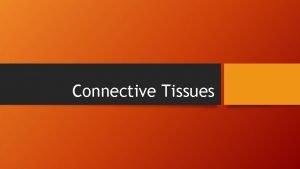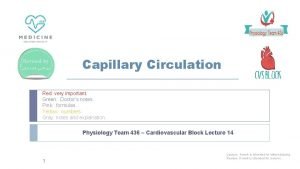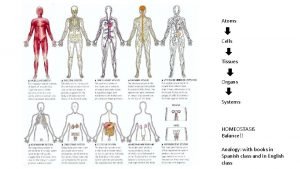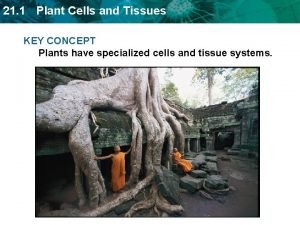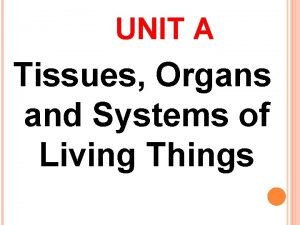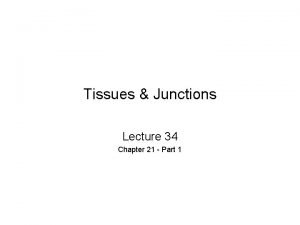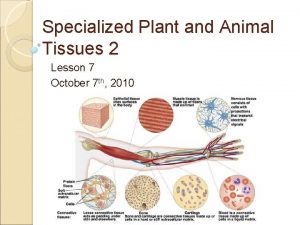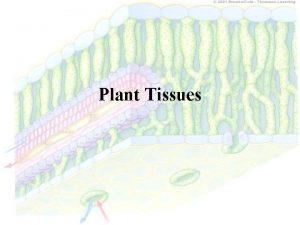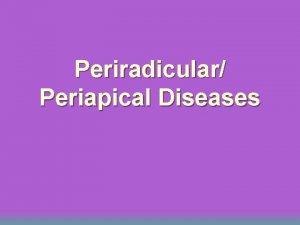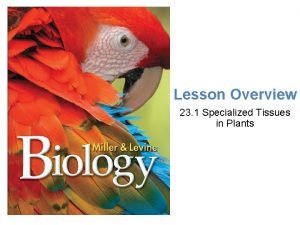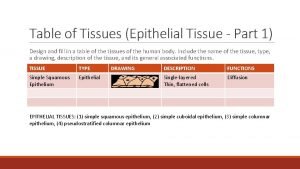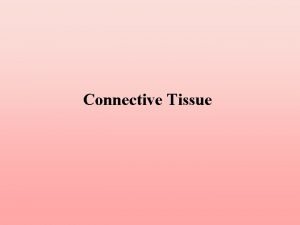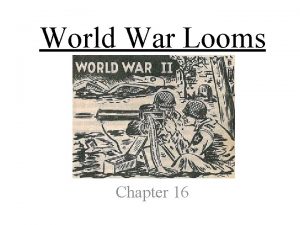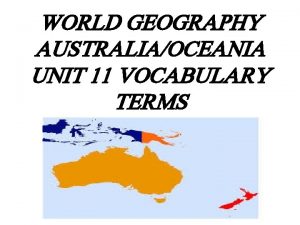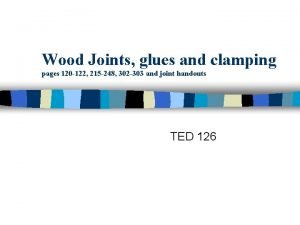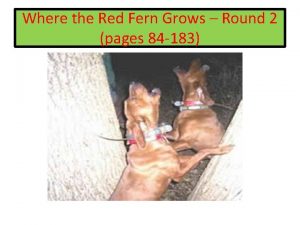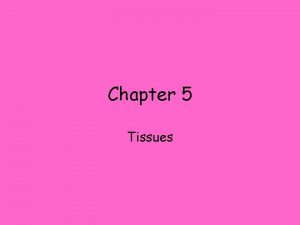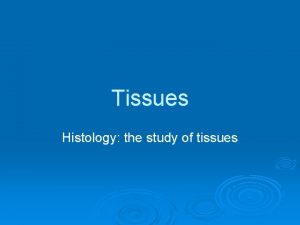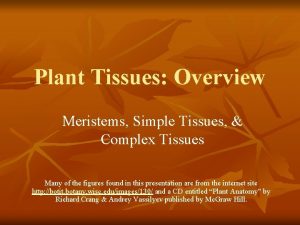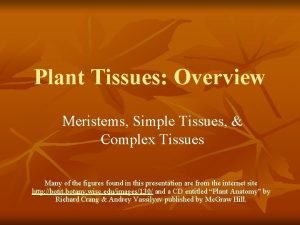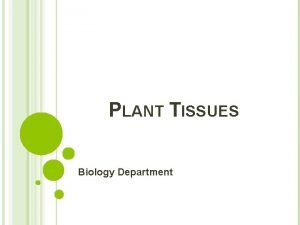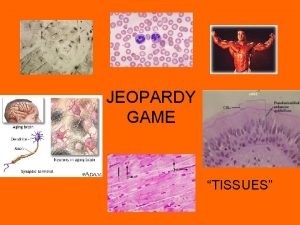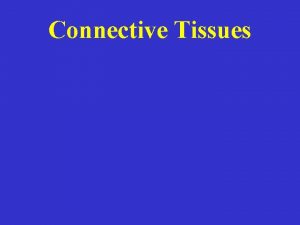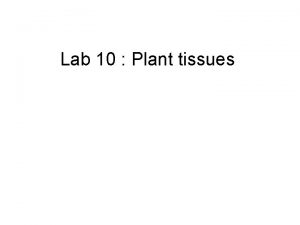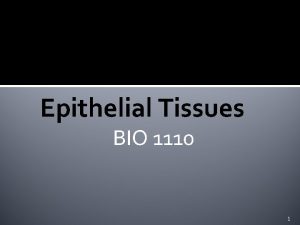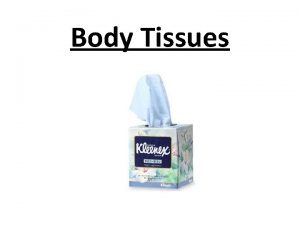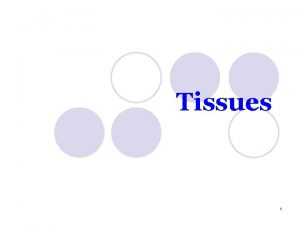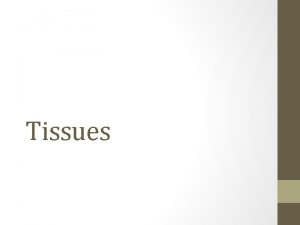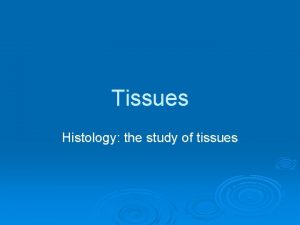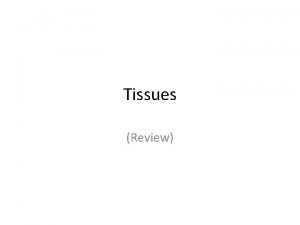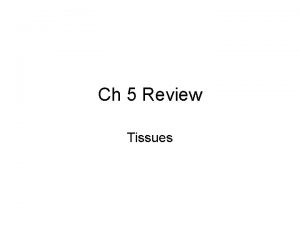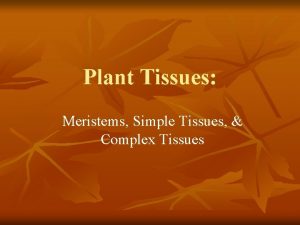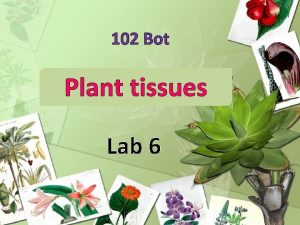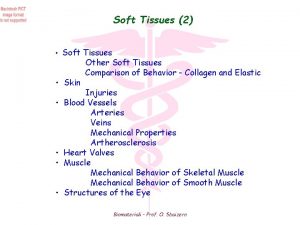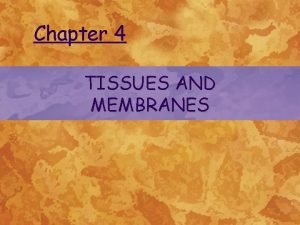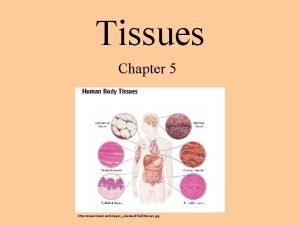Tissues Chapter 5 Tissues 1 2 Tissues are








































































































- Slides: 104

Tissues Chapter 5

Tissues 1. 2. Tissues are groups of cells with a specialized structure and function The cells of different tissues vary in size, shape, arrangement and function a. Within each tissue type there is a lot of similarity

Tissues 3. The cells within a given tissue are held together by an intercellular matrix which varies for each tissue type

Tissues 4. There are four major types of tissues a. b. c. d. Epithelial Tissues Connective Tissues Muscle Tissues Nervous Tissues

Epithelial Tissues 1. All epithelial tissues are found on a surface a. They cover organs, line body cavities and hollow organs b. They always have one exposed surface and it is connected to connective tissue by a basement membrane 2. They are distinguished from each other by their differences in cell shape and cell orientation

Epithelial Tissues 3. Characteristics of epithelial tissues a. b. They lack blood vessels Their nutrients diffuse in from underlying tissues c. They divide readily to replace damaged or dead cells d. The cells are typically very tightly packed (very little intercellular matrix)

Epithelial Tissues 4. Functions of epithelial tissues a. b. c. Protection Secretion Absorption and excretion

Epithelial Tissues 5. 6. Simple epithelial tissues have a single layer of cells Stratified epithelial tissues have multiple layers of cells

Epithelial Tissues 7. Many cuboidal and columnar tissues include cells that are specialized to produce and secrete substances a. One or more of these cells are called glands b. Tissues that contain glands are called glandular epithelia

Simple Squamous Epithelium Characteristics a. i. Single layer of thin, irregularly shaped and flattened cells ii. Easily damaged iii. Divide rapidly

Simple Squamous Epithelium Function b. i. Diffusion and filtration

Simple Squamous Epithelium Location c. i. Alveoli of lungs, capillaries, blood and lymph vessels, covering visceral organs and lining body cavities

Simple Squamous Epithelium These cells come off the stratified squamous epithelial tissue on the inner surface of the cheek. These cells show the irregular, flat shape characteristic of typical "squamous cells. " The nucleus (A) is centrally located, the cell membrane (C) is very thin, and the cell is filled with cytoplasm (B).

Simple Squamous Epithelium This piece of frog skin allows us to observe the irregular shape of and close knit nature of the cells that make up simple squamous epithelial tissue. A - cell membrane B nucleus, C - cytoplasm.

Simple Squamous Epithelium At the left, simple squamous tissue (A) line the walls of blood vessels; at the right it makes up the lung alveoli (A) wall. In both cases the cells are very thin.

Simple Cuboidal Epithelium Characteristics a. i. Single layer of cube shaped cells that are as wide and tall as they are deep

Simple Cuboidal Epithelium Function b. i. Secretion, excretion, and absorption

Simple Cuboidal Epithelium Location c. i. Lining kidney tubules, salivary ducts, pancreatic ducts, ovaries, thyroid gland liver

Simple Cuboidal Epithelium In kidney tissue we find the kidney's tubules cut such that they appear as rings of cells around empty spaces. These cuboidal cells (A) that line these tubules are as wide as they are tall as they are deep - cuboidal. The nuclei (B) are easily observed.

Simple Columnar Epithelium Characteristics a. i. Single layer of elongated cells that are taller than they are wide ii. Nuclei are all at the same level, usually at the base iii. Often contain microvilli to increase absorptive surface area iv. Often have very thin cell membranes

Simple Columnar Epithelium Function b. i. Protection, secretion and absorption

Simple Columnar Epithelium Location c. i. Lining most of the digestive tract and the uterus

Simple Columnar Epithelium The villi of the small intestine are lined by a single layer of columnar cells (A) - thus the name simple columnar epithelium. Note these cells are not as wide as they are tall with the darkly stained nuclei (B) located at the base of the cells. The cell membranes (C) are very thin but easily identified.

Pseudostratified Columnar Epithelium Characteristics a. i. Cells start on the basement membrane but most do not reach the top ii. Cells are columnar in shape but appear to be layered because nuclei are on multiple levels iii. They have cilia which move constantly to move mucus

Pseudostratified Columnar Epithelium Function b. i. Trap and move "pollutants" to the mouth where they are swallowed

Pseudostratified Columnar Epithelium Location c. i. This is a respiratory epithelium being found in such places as the nasal septum, trachea, and bronchi

Pseudostratified Columnar Epithelium Line A cuts through this epithelium. The columnar cells of this tissue all begin at the basement membrane; only a few reach the surface. The nuclei (C) appear at various levels giving the tissue a stratified appearance. The cilia (B) are easily seen.

Stratified Squamous Epithelium a. Characteristics i. ii. Multiple layers of cells (relatively thick) Inner cells are living and actively dividing and pushing older cells up iii. Outer cells are usually flattened and squamous in shape

Stratified Squamous Epithelium Function b. i. Protection

Stratified Squamous Epithelium Location c. i. Outer layer of the skin, mouth, throat, vagina, esophagus, anal canal

Stratified Squamous Epithelium The bracket labeled A marks the stratified squamous epithelium. The many layers of cells that make up this tissue are easily seen with higher magnification (right). Observe that the surface cells (at B) are flattened (are squamous).

Stratified Cuboidal Epithelium Characteristics a. i. Two or three layers of cuboidal cells

Stratified Cuboidal Epithelium Function b. i. Gives more protection than simple cuboidal cells

Stratified Cuboidal Epithelium Location c. i. Line the large ducts of the mammary glands, sweat glands, salivary glands, and the pancreas

Stratified Cuboidal Epithelium Cross-sectional view through a duct of a sweat gland illustrating stratified cuboidal epithelium.

Stratified Columnar Epithelium a. Characteristics i. ii. Multiple layers of cells Superficial cells are elongated (like columnar) and the basal layers are cuboidal

Stratified Columnar Epithelium Function b. i. Protection and secretion

Stratified Columnar Epithelium c. Location i. ii. Stratified columnar epithelium is rare Found in the male urethra, the vas deferens, large salivary glands and parts of the pharynx

Stratified Columnar Epithelium Stratified Columnar epithelium is rare. One place you can find it is in the largest ducts of salivary glands (parotid, submandibular, etc). The basal layer of cells are cuboidal cells and the layer nearest the apical surface includes columnar cells. The large droplets are mucus, in Goblet cells.

Transitional Epithelium Characteristics a. i. Looks similar to stratified cuboidal or stratified squamous when relaxed, but is able to stretch into irregular shapes

Transitional Epithelium Function b. i. Distension (able to change in response to tension)

Transitional Epithelium Location c. i. Bladder, urethra and the ureters

Transitional Epithelium At the left observe the ureter is lined by transitional epithelium (A). At the left the epithelium is more highly magnified. Note that the cells at the exposed surface (A) are large and rounded. They are also larger than the cells at the attached surface (B).

Connective Tissues 1. Connective tissues are a very diverse group of tissues

Connective Tissues 2. Characteristics of connective tissues a. Typically, the cells are farther apart which requires an intercellular matrix i. Usually consists of fibers and a fluid or solid ground substance b. Typically have very good blood supply c. Range from very rigid (bone) to flexible (loose and adipose)

Connective Tissues 3. Because connective tissues are so varied, the have a wide variety of functions a. Bind structures and serve as a framework, provide support and protection, fill spaces, store fat, produce blood cells, fight infections, repair damaged tissues

Connective Tissues 4. There are two groups of connective tissues a. Connective tissue proper consists of the following types of tissues i. Areolar or loose connective tissue ii. Dense regular connective tissue iii. Elastic connective tissue iv. Reticular connective tissue v. Adipose tissue

Connective Tissues 4. There are two groups of connective tissues b. Cartilage, bone and blood

Connective Tissues 5. The most abundant type of cells in connective tissue proper are fibroblasts which produce the fibers in the matrix

Connective Tissues Fibers are composed of protein and there are three major types a. i. Collagenous fibers 1. Thick threads of collagen protein 2. Very strong 3. Called “white” fibers

Connective Tissues a. Fibers are composed of protein and there are three major types ii. Elastic fibers 1. Threads of the protein elastin 2. Very branched 3. Not as strong as collagenous but are able to stretch and return to their original shape 4. Called “yellow” fibers

Connective Tissues a. Fibers are composed of protein and there are three major types iii. Reticular fibers 1. Very thin collagenous fibers 2. Very highly branched

Areolar or Loose Connective Tissue a. Characteristics i. ii. Has many blood vessels Forms many body membranes

Areolar or Loose Connective Tissue a. Matrix i. ii. Gel-like matrix with many fibroblasts Collagenous and elastic fibers

Areolar or Loose Connective Tissue Function a. i. Binds one tissue to another (as skin connects to muscle) ii. Protection and nourishment to the organs and structures it binds iii. Stores body fluids

Areolar or Loose Connective Tissue Location a. i. Beneath the skin and around blood vessels, muscles and nerves

Areolar or Loose Connective Tissue In the gel-like matrix (ground substance) observe the nuclei of fibroblasts (A), collagen fibers (B) and elastic fibers (C).

Dense Regular Connective Tissue a. Characteristics i. ii. Fibers are parallel Have poor blood flow which causes very slow healing iii. Very strong tissue

Dense Regular Connective Tissue a. Matrix i. ii. Very few cells, but most are fibroblasts Closely packed collagenous fibers and many small elastic fibers

Dense Regular Connective Tissue Function a. i. Strong flexible support

Dense Regular Connective Tissue Location a. i. Tendons and Ligaments

Dense Regular Connective Tissue The fibroblasts (A) are clearly observed between the parallel collagenous fibers (B).

Elastic Connective Tissue Characteristics a. i. Fibers can stretch l 1/2 times their length and then recoil ii. Fibers are parallel

Elastic Connective Tissue Matrix a. i. Fibroblasts and elastic fibers

Elastic Connective Tissue Function a. i. Elasticity to tissues

Elastic Connective Tissue Location a. i. Large arteries and bronchial tubes

Elastic Connective Tissue This section of aorta shows a tremendous number of elastic fibers (A). The fibroblasts are not visible. The light pink in this tissue is smooth muscle.

Reticular Connective Tissue a. Characteristics i. Fibers are not parallel

Reticular Connective Tissue Matrix a. i. Fibroblasts and reticular fibers

Reticular Connective Tissue Function a. i. Provide support to soft organs

Reticular Connective Tissue Location a. i. Spleen, lymph nodes and liver

Reticular Connective Tissue Observe that the reticular fibers (A) form a network or lattice in this spleen tissue. Do not confuse this tissue with elastic connective tissue which has fibers that are parallel.

Adipose (or fat) Tissue a. Characteristics i. ii. The nucleus is pushed to the side Stores fat in droplets

Adipose (or fat) Tissue a. Function i. iii. Insulating the body Cushioning joints and organs Storing energy

Adipose (or fat) Tissue Location a. i. Found anywhere in the body where there is excess space and fat can be stored ii. Common below the skin, in spaces between muscles, in the abdomen, and around the heart

Adipose (or fat) Tissue Observe that the nucleus (A) is pushed to the side of the cell giving the cell the appearance of a signet ring. Cells are filled with fat globules (B).

Cartilage a. b. c. Cartilage is a rigid connective tissue Provides support and a framework for attachment Matrix consists of collagenous fibers in a gel-like ground substance

Cartilage d. e. f. Cells are called chondrocytes and are found in spaces called lacunae Surrounded by a covering called the perichondrium which contains the bloods vessels Heals very slowly if damaged

Types of Cartilage i. Hyaline cartilage 1. Very fine collagenous fiber matrix (fibers are usually not visible 2. Is a precursor to bone in the skeletal system 3. Found in the trachea, nose, articular ends of bones and the fetal skeleton

Hyaline Cartilage At the left the bracket indicates the hyaline cartilage. At the right this tissue is more highly magnified. The chondrocytes (A) are located in lacunae (C). The matrix (B) contain collagen fibers that are so fine they are not visible in tissue preparations.

Types of Cartilage ii. Elastic cartilage 1. 2. 3. Dense elastic fiber matrix Provides flexible support Found in the external ears and the larynx

Elastic Cartilage Elastic cartilage is contained within the bracket at the left. This tissue is more highly magnified at the right. The chondrocytes (A) are contained in lacunae (C). The matrix (B) contains abundant elastic fibers. These fibers give great flexibility to this tissue.

Types of Cartilage iii. Fibrocartilage 1. 2. 3. 4. Very tough tissue Chondrocytes are usually in rows Made of collagenous fibers Acts as a shock absorber in the vertebral column, the knees, and the pelvic girdle

Fibrocartilage This cartilage type is recognized by chondrocytes (A) oriented in rows. The lacunae, which hold the chondrocytes, are not visible. The matrix (B) contains numerous fine collagen fibers. These fibers give the tissue durability.

Bone a. b. c. Most rigid connective tissue Functions for support, protection, salt storage, blood cell production, and muscle attachment Cells are called osteocytes and they are found in lacunae

Bone d. e. Osteocytes are connected by channels called canaliculi Calcium salts are stored between cells

Bone In the compact bone micrograph at the left, several complete osteons are visible. In the center of the osteon is the central canal (A) which hold the blood vessels and a nerve. These canals are surrounded by concentric rings of inorganic matrix, the lamellae (B). Between the lamellae are bone cells, the osteocytes (C) located in lacunae. Nutrients diffuse from cell to cell through the canaliculi (D).

Blood a. b. c. Functions to transport materials within the body (O 2, CO 2, nutrients) Cells are red blood cells, white blood cells, and platelets Matrix is a fluid called the plasma

Blood

Skeletal Muscle Tissue a. Characteristics i. iii. iv. Can be controlled consciously Have striations (light and dark banding) Have multiple nuclei Stimulated to contract by nerve impulses v. Extend the length of the muscle

Skeletal Muscle Tissue Function b. i. Responsible for voluntary movement

Skeletal Muscle Tissue Location c. i. Found in the muscles that attach to bones

Skeletal Muscle Tissue Skeletal muscle cells run the full length of a muscle. Line A shows the width of one cell (fiber). Note the striations characteristics of this muscle type. These cells are multicellular, B marks one nucleus.

Smooth Muscle Tissue a. Characteristics i. iii. iv. Lacks striations Smaller cells that skeletal muscle Spindle shaped cells Single nucleus

Smooth Muscle Tissue Function b. i. Involuntary movement 1. 2. Churning and moving food Moving urine

Smooth Muscle Tissue Location c. i. Found lining the organs of the digestive track, urinary track and blood vessels

Smooth Muscle Tissue Smooth muscle cells are spindle shaped and uninucleate

Cardiac Muscle Tissue Characteristics a. i. Cells join end to end 1. Produces branched fibers 2. Junctions are called intercalated disks ii. Each cell has a single nucleus iii. Controlled involuntarily

Cardiac Muscle Tissue Function b. i. Involuntary, rhythmic contraction

Cardiac Muscle Tissue Location b. i. Only found in the heart

Cardiac Muscle Tissue Cardiac muscle cells branch, are striated, are uninucleate (B) and have intercalated discs (A).

Nervous Tissue 1. 2. Found in the brain and spinal cord Composed of two types of cells, neurons and neuroglial cells

Nervous Tissue Neurons (nerve cells) a. i. b. Transmit impulses as a form of communication Neuroglial cells i. ii. Support and bind nervous tissue Connect neurons to blood vessels

Nervous Tissue The cell body is labeled A. The cell's axon can not be distinguished from its dendrites in this micrograph. B marks the axon and dendrite threads. C marks the neuroglial cells (dark spots).
 Insidan region jh
Insidan region jh Body tissues chapter 3 cells and tissues
Body tissues chapter 3 cells and tissues Body tissues chapter 3 cells and tissues
Body tissues chapter 3 cells and tissues Body tissues chapter 3 cells and tissues
Body tissues chapter 3 cells and tissues Stained cheek cell
Stained cheek cell Eisonophil
Eisonophil Chapter 6 bones and skeletal tissues
Chapter 6 bones and skeletal tissues Which part of the cell contains genetic material
Which part of the cell contains genetic material Cell membrane phospholipids
Cell membrane phospholipids Chapter 5 tissues
Chapter 5 tissues Chapter 3 cells and tissues figure 3-1
Chapter 3 cells and tissues figure 3-1 Specialized connective tissue
Specialized connective tissue Types of tissues
Types of tissues What are the three primary meristems
What are the three primary meristems 3 tissues of a plant
3 tissues of a plant Akar dikotil
Akar dikotil Jane campion tissues
Jane campion tissues Upper epidermis function in photosynthesis
Upper epidermis function in photosynthesis Tissues causes of civil war
Tissues causes of civil war Supportive connective tissue
Supportive connective tissue Characteristics of connective tissue
Characteristics of connective tissue Tissues are groups of similar cells working together to
Tissues are groups of similar cells working together to Genetic effects on gene expression across human tissues
Genetic effects on gene expression across human tissues Types of cells in loose connective tissue
Types of cells in loose connective tissue Types of tissues
Types of tissues What are the four primary tissue types
What are the four primary tissue types Tissues are groups of similar cells working together to
Tissues are groups of similar cells working together to Tissue structure poem
Tissue structure poem Types of tissues
Types of tissues What macromolecule is a prominent part of animal tissues
What macromolecule is a prominent part of animal tissues Cells-tissues-organ-systems-organism
Cells-tissues-organ-systems-organism Supportive tissues
Supportive tissues Exercise 6 tissues
Exercise 6 tissues Identify the cells
Identify the cells Types of tissues
Types of tissues Endocrine tissues
Endocrine tissues Four major tissue types
Four major tissue types Tissues working together
Tissues working together A tissue is a group of cells having
A tissue is a group of cells having The circulatory system includes
The circulatory system includes Simple cuboidal cells
Simple cuboidal cells Plastid
Plastid Goblet cells cilia and microvilli
Goblet cells cilia and microvilli Periradicular diseases
Periradicular diseases What do all connective tissues have in common
What do all connective tissues have in common Capillary
Capillary Analogy of tissues
Analogy of tissues Plant tissues
Plant tissues Cell membrane function
Cell membrane function What is tissues
What is tissues Tissues are groups of similar cells working together to:
Tissues are groups of similar cells working together to: Tissues
Tissues Sclerenchyma
Sclerenchyma Periradicular tissues are
Periradicular tissues are Tissues in plants
Tissues in plants Table tissue design
Table tissue design Fetal station
Fetal station Hyaline cartilage location
Hyaline cartilage location Tissue are grouped together to form various
Tissue are grouped together to form various The red tent summary
The red tent summary Gatsby ch 8 summary
Gatsby ch 8 summary Chapter 10 chemical reactions
Chapter 10 chemical reactions Chapter 11 assessment chemistry
Chapter 11 assessment chemistry Chapter 9 chemical reactions answers
Chapter 9 chemical reactions answers Chapter 7 similarity
Chapter 7 similarity Chapter 6 career readiness chapter review answers
Chapter 6 career readiness chapter review answers 7 ionic and metallic bonding
7 ionic and metallic bonding Chapter 9 surface water answer key
Chapter 9 surface water answer key Chapter 2 study guide representing motion
Chapter 2 study guide representing motion The central science 14th edition
The central science 14th edition Chapter 7 ionic and metallic bonding assessment answer key
Chapter 7 ionic and metallic bonding assessment answer key Chapter 4 section 1 population dynamics study guide
Chapter 4 section 1 population dynamics study guide Chapter 2 standardized test practice answers
Chapter 2 standardized test practice answers Facts about the philippian jailer
Facts about the philippian jailer Ionic compounds properties
Ionic compounds properties 7 ionic and metallic bonding practice problems
7 ionic and metallic bonding practice problems Chapter 9 chemical names and formulas chapter quiz answers
Chapter 9 chemical names and formulas chapter quiz answers Zeta phi beta membership intake process manual
Zeta phi beta membership intake process manual Working with young children chapter 1
Working with young children chapter 1 Emily bronte summary
Emily bronte summary Wuthering heights chapter 6
Wuthering heights chapter 6 Findings of qualitative research
Findings of qualitative research Gbyeg
Gbyeg Chapter 16 world war looms vocabulary
Chapter 16 world war looms vocabulary Chapter 27 world war 1 and the russian revolution
Chapter 27 world war 1 and the russian revolution Chapter 27 lesson 4 world war 1 ends
Chapter 27 lesson 4 world war 1 ends Chapter 17 section 3 world history
Chapter 17 section 3 world history Chapter 32 assessment world history
Chapter 32 assessment world history Chapter 30 section 2 world history
Chapter 30 section 2 world history Chapter 8 nationalist revolutions sweep the west
Chapter 8 nationalist revolutions sweep the west Chapter 15 section 1 world history
Chapter 15 section 1 world history Chapter 10 section 2 central america and the caribbean
Chapter 10 section 2 central america and the caribbean Ap human geography chapter 11 vocab
Ap human geography chapter 11 vocab World geography chapter 3 climates of the earth
World geography chapter 3 climates of the earth Work design and measurement
Work design and measurement Unit 14 lesson 1 drivers ed
Unit 14 lesson 1 drivers ed Chapter 7 wood joints
Chapter 7 wood joints Glue
Glue Wilson fights for peace
Wilson fights for peace Why study financial institutions
Why study financial institutions Why be happy when you could be normal chapter summary
Why be happy when you could be normal chapter summary Where the red fern grows chapter 10
Where the red fern grows chapter 10 Ap psychology chapter 14
Ap psychology chapter 14 The great gatsby quiz
The great gatsby quiz Approach chemistry chalk chapter
Approach chemistry chalk chapter






